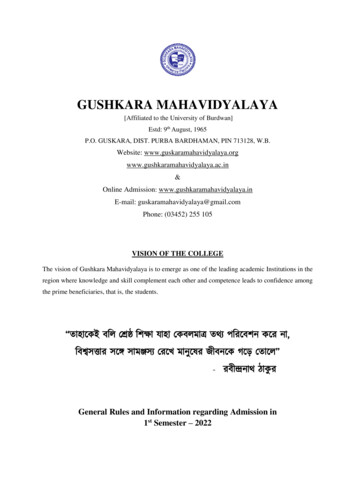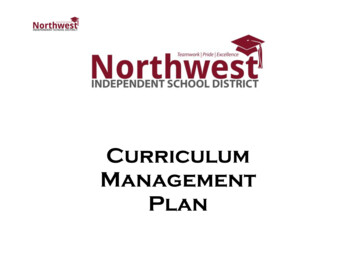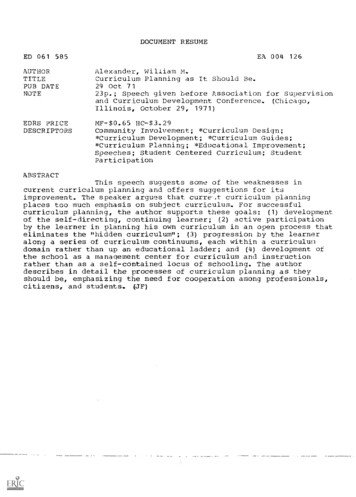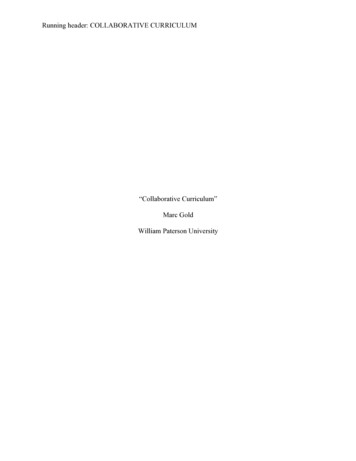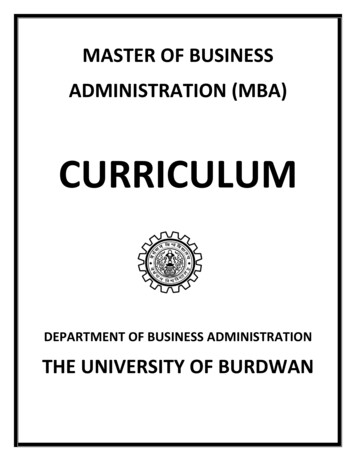
Transcription
MASTER OF BUSINESSADMINISTRATION (MBA)CURRICULUMDEPARTMENT OF BUSINESS ADMINISTRATIONTHE UNIVERSITY OF BURDWAN
MBA PROGRAMME DESIGN & REQUIREMENTSDepartment of Business AdministrationThe University of --------------------------------------------THE PROGRAMMEThe Master of Business Administration (MBA) is a two-year full time programme offered by theDepartment of Business Administration, The University of Burdwan. This programme was introducedby the University with the approval of the University Grants Commission (UGC) long back in the year1983. Necessary technical approval for the programme has been obtained by the University from AllIndia Council for Technical Education (AICTE) from time to time.PROGRAMME OBJECTIVESThe Programme is designed to turn out a cadre of future managers thoroughly conversant with generalprinciples of management along with tools and techniques pertinent thereto. The programme is alsoaimed to churn out future managers with specializations in the areas of Marketing, Finance, HumanResource Management and Systems, Operations & Decision Sciences.PROGRAMME STRUCTUREThe courses for the MBA programme are offered in the following areas:Area – I: General ManagementArea – II: Organisational BehaviourArea – III: EconomicsArea – IV: Strategic ManagementArea – V: Marketing ManagementArea – VI: Financial ManagementArea – VII: Human Resource ManagementArea – VIII: Systems, Operations & Decision Sciences1
PROGRAMME ADMINISTRATIONIn order to complete the MBA programme, a student is required to obtain 100 credits from the different areasalong with two compulsory special courses viz. (i) Summer Project and Viva (SPV) and (ii) Comprehensive Report(CR). Each of the courses in the identified areas carries 3 credits. Summer Project (SP) and Dissertation/Reportcarry 5 credits each. The credit distribution for the programme is as follows:1. 60 credits from 20 core courses.2. 24 credits from 8 elective courses exclusively from one of the four specialization areas viz. (A)Marketing Management, (B) Financial Management, (C) Human Resource Management, (D) Systems,Operations & Decision Sciences.3. 6 credits from 2 elective courses from the areas excluding the four specialization areas.In lieu of these two elective courses, a student can opt for courses offered by allied departments as nondepartmental electives and can earn a maximum of 6 credits.4. 10 credits from Summer Project (5 credits) and Dissertation/ Report (5 credits).The other details relating to the programme based on Choice Based Credit System (CBCS) are as follows: A candidate can opt for a maximum of 30 credits per semester. A theoretical course of 3 credits involves 30 lecture hours including tutorials. Each course carries 100 marks of which 20 % will be reserved for internal assessment for alltheoretical courses and the remaining 80 % will be for written examination. Internal Assessment willbe made during the semester on the basis of attendance (25%) and assignment/class test/viva(75%). The elective courses to be offered to the students will be decided every semester by theDepartmental Committee. All the students will have to undergo Summer Project (SP) of 8 to 10 weeks duration with anindustrial/business/service/social organization by taking up a project study. The SIP report will carry80 Marks and the viva voce to be conducted on the SIP will carry 20 Marks. Course MBA 107 (Comprehensive Report) will be segregated into three components: Final ProjectStudy Report 50 marks, Field Study/Field Survey Report– 25 marks and Social Outreach ActivitiesReport – 25 marks. A student has to take up the final project study in his/her area of specialisation.Field Study will be based on Industry visit(s) to be organised by the department during theprogramme. Social outreach activities will be based on components like visit to villages andidentification of socio-economic issues on rural livelihood, serving the interests of informal workers,career counseling for the students of the excluded group, participation in literacy camps and othertypes of activities as specified and approved by the department. A single report comprising threeseparate sections on Final Project Study, Field Study/Field Survey and Social Outreach Activities willhave to be submitted within the deadline set by the department. Students from other departments can opt for the elective papers from the different areasby obtaining necessary permission from their concerned department. All issues relating to programme administration in the CBCS will be governed by the decision of thedepartmental committee and the existing rules and regulations of the university.The modified curriculum under Choice Based Credit System (CBCS) mode will come into effect from theacademic session (2014-2016) to be commenced from July, 2014.2
PROGRAMME STRUCTUREAREACORE COURSESCOURSECODEMBA 101MBA 1021. GeneralManagementMBA 103MBA 104COURSE NAMEManagement Process &Organisation Theory (MPOT)Business Environment (BE)Managerial Communication andSkill Development (MCSD)Research Methodology (RM)ELECTIVE COURSESCOURSECODECOURSE NAMEMBAE 108Corporate Governance (CG)Corporate Social Responsibilityand Business Ethics (CSR & BE)MBA 106 Summer Project & Viva (SPV)MBA 107 Comprehensive Report (CR)MBA 1052.OrganisationalBehaviour3. EconomicsMBA 201Understanding IndividualEmployee Behaviour (UIEB)MBAE 204ErgonomicsMBA 202Managing Interpersonal andGroup Processes (MIGP)MBAE 205Corporate Success Behaviour(CSB)MBAE 206MBA 203Organisational Change andDevelopment (OCD)MBA 301Managerial Economics (ME)MBAE 304MBA 302Entrepreneurship Development(ED)Economics of HumanResources (EHR)MBAE 305Development Economics (DE)MBA 303International Business (IB)MBAE 306Social Entrepreneurship (SE)MBAE 307Indian Economic Environment(IEE)MBAE 308Project Management (PM)MBAE 207MBAE 4024. StrategicManagementEmployee Non-CognitiveBehaviour (ENB)Group and Team Effectiveness(GTE)MBA 401Introductory StrategicManagement (SM)MBAE 403MBAE 404Corporate Creativity andStrategic Innovation (CCSI)Industrial Organisation andCompetitive Strategies (IOCS)Strategic Management of NonProfit Organisations (SMNPO)3
AREA5. MarketingManagementCORE COURSESCOURSECODEMBA 501COURSE NAMEFundamentals of MarketingManagement (FMM)ELECTIVE COURSESCOURSECODECOURSE NAMEMBAE 502Consumer Behaviour (CB)MBAE 503Sales and Distribution (SD)MBAE 504Brand Management (BM)MBAE 505Retail Marketing (RTM)MBAE 506Advertising (ADV)MBAE 507Rural Marketing (RMM)MBAE 508Service Marketing (SVM)MBAE 509Strategic Marketing (SM)MBAE 510Voluntary Sector Marketing(VSM)MBAE 511Events Marketing Management(EMM)MBAE 512Industrial Marketing (INDM)MBAE 513Integrated MarketingCommunication (IMC)MBA 601Accounting for Managers (AFM)MBAE 603MBA 602Corporate Finance (CF)MBAE 604MBAE 605MBAE 606MBAE 6076. FinancialManagementMBAE 608MBAE 609MBAE 610MBAE 611MBAE 612MBAE 613MBAE 614Financial Markets and FinancialMathematics (FMFM)Corporate Reporting (CR )Financial Engineering(FE)Working Capital Management(WCM)Security Analysis & PortfolioManagement (SAPM)Advanced Corporate Finance(ACF)International FinancialManagement (IFM)Taxation (TAX)Auditing (AUD)Financial Statement Analysis(FSA)Corporate Restructuring(CORES)Business Valuation (BV)4
AREACORE COURSESCOURSECODECOURSE NAMEELECTIVE COURSESCOURSECODEMBAE 702MBAE 703MBAE 704MBAE 705MBAE 7067. HumanResourceManagementMBA 701Fundamentals of Human ResourceManagement (FHRM)MBAE 707MBAE 708MBAE 709MBAE 710MBAE 711MBAE 712MBAE 713MBA 801MBA 802MBA 803MBA 804Quantitative Techniques inManagement (QTM)Fundamentals of Production &Operations Management (FPOM)Management Information System(MIS)Operations Research (OR)MBAE 805MBAE 806MBAE 807MBAE 808MBAE 8098. Systems,Operations &DecisionSciencesMBAE 810MBAE 811MBAE 812MBAE 813MBAE 814MBAE 815MBAE 816COURSE NAMEHuman Resource Planning(HRP)Compensation and RewardManagement (CRM)Employment Relations (ER)Labour Laws (LL)Strategic Human ResourceManagement (SHRM)Performance Management &Employee Development (PM &ED)Managerial Counselling &Negotiation Skills (MCNS)International Human ResourceManagement (IHRM)Contemporary Interventions inHuman Resource Management(CIHRM)Training & development (T & D)Human Capital Management(HCM)Employer Branding (EB)Total Quality Management(TQM)Database Management System(DBMS)Production Planning & Control(PPC)Business Process Reengineering(BPR)Purchasing & MaterialsManagement (PMM)Logistics & Supply ChainManagement (LSCM)Systems Analysis & Design (SAD)Knowledge Management &Business Excellence (KMBE)Decision Support System (DSS)Project Management (PM)E-Business (EB)Applied Operations Research(AOR)5
AREA - I : GENERAL MANAGEMENTCORE COURSESMBA 101: MANAGEMENT PROCESS AND ORGANIZATIONAL THEORY (MPOT)Unit I: Understanding an Organisation—Organisational Adaptation, Survival and Growth—Nature, Purpose andImportance of Management in Organisations- The Management Process–Kinds of Managers-Basic ManagerialSkills and Roles, Changing Nature of Managerial Work–Management: Science or Art–Management as aProfession. Evolution of Management Thought: Classical Management Approaches, Behavioural ManagementApproaches, Quantitative Management Approaches, Modern Management Approaches, ContemporaryManagement Issues and Challenges–Global Dimensions of Management.Unit II: Planning & Decision Making: Planning–Concept, Importance, Types or Elements of Plan, Levels ofPlanning, Steps in Planning, Benefits and Limitations of Planning–Making Planning Effective– Management byObjectives. Decision Making–Types of decisions, Nature of decision making, Rational Perspectives andBehavioural Aspects of decision making.Unit III: Organising: Concept, Nature, Importance and Process of Organising–Organisation Structure andDesign–Departmentation–Span of Management––Concepts of Authority, Responsibility and Accountability–Delegation of Authority–Steps–Centralisation and Decentralisation of Authority–Factors determining the degreeof Decentralisation of authority–Concept of Line, Staff and Functional authority–Conflict between Line andStaff–Overcoming the Line –Staff Conflict.Unit IV: Controlling: Concept, Nature and Importance of Controlling–Critical Control points and standards–Typesof Control–Requirements of an Effective Control System–Behavioural Implications of Control–Some Techniquesof Managerial control.Unit V: Organisation Theory: Organisations as systems– Strategic Systems Approach– Brief history of OT–Contemporary perspective– Organisational goals and effectiveness– Structure and design– Nature of Structureand Design, Differentiation & Integration, Patterns of strategic organisational design, evolving designs–Organisational Culture– Organisational size and life cycle– Organisational Decline and Downsizing–Organisational size and control strategies.Suggested Readings:1. Heinz Weihrich, Management: A Global Perspective, Tata McGraw Hill.2. John R. Schermerhorn, Management, Wiley-India3. Robbins and Coulter: Management, Tata McGraw Hill.4. D. R. Hampton: Management, Tata McGraw Hill.5. Herbert A. Simon: Administrative Behaviour, Collier Macmillan Publishers, London6. Jackson and Morgan, Organisation Theory, Prentice Hall, Inc., Englewood Cliffs, New Jersey7. Katz and Rosenzweig: Organisations and Management, McGraw-Hill Book Company8. March and Simon: Organisations, John Wiley and Sons.MBA 102: BUSINESS ENVIRONMENT (BE)Unit-I: Overview and Framework of Business Environment-Economic Environment: Economic Development andHuman Development; Different elements of economic environment; Role of Govt. of India; Industrial Policy;Fiscal Policy; Monetary policy; Economic reforms; Liberalization; Privatization and Globalization; StructuralAdjustment Programme; Current trends in economic environment affecting business.Unit-II: Social Environment: Changing objects of business; change in organizational culture; Consumers rights &protection; Ecological issues; Adoption of cross-cultural issues by multinational and transnational Companies:International experience NGOs and their operation.Unit-III: International environment: Foreign Collaboration and cross border M& As; Multinational corporationsand Globalisation; Foreign Capital and Foreign Investment; WTO & GATT.6
Unit-IV: Business Legislations: Elements of Contract Act, Sale of Goods Act, Company law, Cyber law,Competition Laws, Right to Information Act, Legal issues relating to consumer protection, environmentprotection and reporting etc.Unit-V: Techno-legal Environment of Business: Technology policy in India; Policy on R&D; Intellectual PropertyRights; Patent, Trade mark and copy rights. Infringement of IPR; Technology Transfer & related issues.Suggested Readings:1. K. Aswathappa, Business Environment for Strategic Management, Himalaya Publishing.2. Mishra &Puri, Economic Environment, Himalaya Publishing.3. M.Adhikari, Economic Environment of Business, Sultan Chand & Sons.4. Narayanan, Intellectual Property Rights, Eastern Law Book House, Kolkata.5. A.C. Fernando, Business Environment, Pearson Education.MBA 103 MANAGERIAL COMMUNICATION AND SKILL DEVELOPMENT (MCSD)Unit-I: Managerial communication-nature and scope of communication, functions of communication; roles of amanager, communication process; communication network; Informal Communication.Unit-II: Road blocks to managerial communication; Removing roadblocks; Gateways to communication,strategies for improving organizational communication; cross cultural communication and communicationbetween genders; Effective Listening-Poor listening habits, types of listening; strategies for effective listening;Persuasive communication and Role of Mentoring.Unit-III: Business presentations & public speaking-Introduction to a presentation, main body and conclusion,controlling nervousness & stage fright; business presentation; sample outlines; Conversations; Essentials of abusiness conversation.Unit-IV: Business writing-Introduction, written business communication; Business letters, Common componentsof Business Letters; writing effective memos; Business reports & Proposals; format for proposals; proposallayout and design; Secretarial Practices in Business Organizations.Unit-V: Non-verbal communication-introduction; Elements of non-verbal communication-Kinesics, Proxemics,Chronemics, Paralinguistic, Hap tics etc; Interpreting non-verbal messages.Suggested Readings:1. Meenakshi Raman & Parkash Singh, Business Communications, Oxford.2. McGrath, E.H., Basic Managerial skills For All, PHI, New Delhi.3. Lesikar, R and Pettit, J, Business Communication, All-India Traveller Bookseller, New Delhi.4. Monnipally, M.M., Business Communication Strategies, TMH, New Delhi.MBA 104 RESEARCH METHODOLOGY (RM)Group – A (Qualitative Research Methods)Unit-I: Qualitative and quantitative research approaches, what qualitative research does in a market place,application of qualitative methods for marketing; Issues and concerns in qualitative research, steps to qualitativeresearch study design.Unit-II: Different Qualitative Research Models: History, Living Biography and Self-Narrative; Case study method,Phenomenology and Grounded theory; and Ethnographic Approach in qualitative research study.Unit-III: Qualitative Data Collection: Techniques and Tools; Observation and fieldwork; field interviews,structural interviews; projective techniques, WAT. Qualitative Text Analysis and Reporting: Analysis of visual andmaterial text; analysis of verbal data, writing field stories and narrative reports.7
Group – B (Quantitative Research Methods)Unit-IV: Business Statistics and sampling Theory: An overview of Business Statistics – Introduction, Importantdefinitions, Measures of Central Tendency, Homogeneous Population, Estimates, Power of a Test, Testing ofHypothesis. An overview of Sampling Theory: Introduction, Basic Principles, Sampling Plan, Sample Design,Sampling Techniques, Types of Sampling Schemes.Unit-V: Data Analysis and Statistical Techniques: Analysis of Data – Preparing data for Analysis, ExaminingRelationships and Trends using Statistics, Selecting an Appropriate Statistical Technique, Tabulation of Data,Analysis of Data – Use of SPSS and other Statistical Software Packages. Advanced Techniques for Data Analysis:ANOVA, Discriminant Analysis, Factor Analysis, Conjoint Analysis, Cluster Analysis, and Multi- dimensionalScaling Techniques.Suggested Readings:1. Daymon, Christine and Holloway, Immy; Qualitative Research Methods in Public Relation and MarketingCommunications; Routledge, U.K.; Publication, 2002.2. Craig; C. Samuel and Douglas, Susan P.; International Marketing Research; John Wiley and Sons Ltd, IIIrdEdition, 2005; U.K. and U.S.A., New York.3. Gummesson, Evert; Qualitative Methods in Management Research, Second Edition, Sage PublicationsInc., New Delhi.4. Bim, Robin. J; The Effect Use Market Research: A Guide for Management to Grow the Business, ThirdEdition, Kogan Page, London, U.K.MBA 105 CORPORATE SOCIAL RESPONSIBILITY (CSR)Unit-I: Corporate social responsibility-Fundamentals, Evolution, Optimizing CSR, Why and when to apply CSR,Managing, Monitoring and Reporting- Role of corporation as part of community-basic human rights,constitutional obligations, social practice—Social Accounts Matrix—Social Indicators (SA 8000, GRI).Unit-II: Strategic CSR-Competing Strategy Perspectives, The Resource perspective, The Industry perspective, TheStakeholder perspective-The strategic context of CSR-The integration of CSR into strategy and culture-The CSRFilter- Implementing CSR-CSR Threshold-CSR Issues and Case studies.Unit-III: Concept of Corporate Governance- Shareholders, Directors, Management- Models of CorporateGovernance- Perspectives and Practices –CSR, Good Corporate Governance and Reputation Risk-CSR andCorporate SustainabilityUnit-IV: UN global compact-global corporate citizenship, national and international guidelines.Unit-V: Legislations and CSR- Companies Act, 2013. Present CSR Practices in India, Case studiesSuggested Readings:1. H.H. Johnson, Business in contemporary society-framework & issues, Wadsmortu Publishing Co Ltd2. J. Wempe and M. Kaptain, The balanced company: A theory of corporate integrity, OxfordUniversity3. Philip Kolter and Nancy Lee, Corporate Social Responsibility: Doing the Most Good for Your Companyand Your Cause, Wiley India4. William B Werther and David Chandler, Strategic Corporate Social Responsibility: Stakeholders in aGlobal Environment, SageMBA 106: SUMMER PROJECT & VIVA (SPV)MBA 107: COMPREHENSIVE REPORT (CR)8
ELECTIVE COURSEMBAE 108: CORPORATE GOVERNANCE (CG)Unit I: Understanding a Corporation and its facets– Corporation as a Complex Adaptive System– Governancetypes– Governance and Management–Governance theories–Separation of Ownership and Control–Instances ofgood and bad governance practices.Unit II: Directors vis-à-vis monitoring a corporation– Directors in historical perspective– Types of Directors–Board Duties: The Legal Framework–Board: Structure, Size–Director Effectiveness–Board Committee Types.Unit III: Management-Performance Relationship–Issues relating to Executive compensation–Stock Options–Recent Shareholder Concern–Best Governance practices–Corporate Fraud: significant cases.Unit IV: Important Corporate Governance codes and Principles in India–International Corporate Governance:Corporate governance practices in USA, UK and other countries.Unit V: HR perspective of Corporate Governance: Personal and Interpersonal governance–Integration ofEmployees, Owners and directors–Employees: Compensation and Ownership–Future directions of CorporateGovernanceSuggested Readings:1. R. Monks and N. Minow, Corporate Governance, Blackwell Publishing2. E. Yocam and A. Choi, Corporate Governance: A Board Director's Pocket Guide: Leadership, diligenceand Wisdom, iUniverse.3. A. C. Fernando, Corporate Governance: Principles, Policies and Practices, Pearson Education India.4. Lynn McGregor, The Human Face of Corporate Governance, Palgrave Macmillan5. B Tricker, R I Tricker, Corporate Governance: Principles, Policies and Practices, Oxford University Press.6. Bhattacharya, S.K. Achieving Managerial Excellence: Insights from Indian Organisations. Macmillan7. Jha, P.N. Changing Perspectives of Business Excellence. Macmillan Publishers India Ltd.AREA - II : ORGANISATIONAL BEHAVIOURCORE COURSESMBA 201: UNDERSTANDING INDIVIDUAL EMPLOYEE BEHAVIOUR (UIEB)Unit I: Understanding Employee Behavior - Knowing employee behavior -- Thrust on human behavior[Stimulus(S)-Organism (O)—Behavior (B)—Consequence(C)] model—Cognition as the basis of behavior[Interaction of cognitive and non-cognitive factors] ---Understanding others—Facial expression—Bodylanguage—touching—Non-verbal behavior & social interaction [Role of micro expressions, Attribution & Somebasic source of bias] ---Social cognition.Unit II: Interdisciplinary Approach to Study Human Behavior - Comprehending individual behavior---Contributions of different disciplines---Workforce diversity & its implications---Challenges & opportunities tostudy employee behavior---Globalization & Changing trends of the workforce—Responding to outsourcing--Demand for the customer service & public relations---Boundary spanning activities---Demand for thedevelopment of the individual skills---Skill & Role analysis---Coping with temporariness---working in networkedorganizations---Work-life conflicts--- Making better the ethical behavior of the employee-----Need to Knowindividual employee---- Absenteeism, Turnover, Deviant work place behavior versus Organizational citizenshipbehavior[OCB].Unit III: Basis of Employee Behavior - Ability [Intellectual, physical &ability-job fit ]—BiographicalCharacteristics---Learning [Theories, social learning, principles of learning & managing employee behavior--9
Shaping: a tool to manager—methods of shaping—Behavior modification]—Employee attitudes[Components—A-B link, cognitive dissonance &major job attitudes—job satisfaction &its measurement—organizationalcommitment---job involvement]---Significance of attitudes to study employee behavior-and major implications.Unit IV: Foundations of Individual employee behavior-Personality & values [Determinants—MBTI—Big fivemodel—Measurement of personality---Major personality attributes—National culture and personality--importance of values—types of values—work cohort—values & ethical behavior—values across culture—ethicalissues at workplace and linkage with individual’s personality---person-job fit]--- Perception and individualdecision making[ Perceptual selectivity—perceptual organization—Figure-ground relationship & applications--perceptual defenses—factors influencing perception---attribution----a few important biases—shortcuts injudging others& specific relevance—linking perception &individual decision-making—rational decision-making--creativity in decisions—bounded rationality & common biases and errors---ethics in decision-making]Unit5: Non cognitive behavior of the employees-Human motives and the process of motivation—A few theoriesof work motivation [Theory X & Y, Maslow, Herzberg, Alderfer, Vroom & Equity theory]—job characteristicsmodel—job rotation, enlargement &enrichment—employee recognition programs]---Affect-emotion & mood—emotional labor—felt and displayed emotion---AET---EI—Applications of emotions and moods in the workplace.Suggested Readings:1. Armstrong, M.(1995). A handbook of personal management practices (5th Ed). London: Kogan Page.2. Baron, R, A, & Byrne, D,. (1995).Social psychology (7th Ed.). New Delhi: Prentice-Hall of India.3. Ivancevich,J.M. , Konopaske,R., & Matteson,M,T.(2008). Organizational behavior and management (7thEd.), New Delhi: Tata McGraw-Hill.4. Kreitner, R., & Kinicki, A., Organizational behavior (8th Ed.). New Delhi: Tata McGraw-Hill.5. Luthans, F(1987). Organizational behavior. NY: McGraw-Hill.6. McShane,S.L., Glinow, VA,M.,& Sharma,R,R Organizational behavior. New Delhi: Tata McGraw-Hill.7. Robbins, S, P., Judge,T,A., & Sanghi,S, Organizational behavior, Delhi: Pearson Prentice- Hall.MBA 202: MANAGING INTERPERSONAL AND GROUP PROCESSES (MIGP)Unit-I: Understanding others – Nonverbal communication, Attributions, Importance of socio-cultural diversity,Significance of verbal communication in sustaining the relationship – the role of language; Transactional Analysis(TA). Social cognition – Mental shortcuts, Attitudes [Formation, A-B link, Persuasion, Cognitive dissonance, Selfconcept, Attitudes about oneself, Differential expectations of competence, Implications of self-monitoringbehaviour, Self focusing, Gender identity.Unit-II: Interpersonal attraction – Proximity and emotion, Affiliation need, Friendship – similarity & reciprocity,Loneliness, Role of prejudice & discrimination in affecting the relationships.Unit-III: Conformity [Factors affecting – Cohesiveness, Group size, and Social support], Gender differences andconformity, Compliance, Obedience, Providing help to others, Aggression and its control in the organization.Unit-IV: Groups and individuals – Group formation & functions, Performance in the presence of others, Thefamily – Functions, Roles in decision making, Life Cycle-Social class [Measurement, Geo-demographic clustering,Lifestyle profiles of the social classes & influences upon group functions – Decision making by groups andpolarization, Gender differences in leadership, Influential views of leadership, transformational leadership.Unit-V: Team Building and Interpersonal Process: Process Consultation - Team building -Team building activitiesTypes of team building - role in team building- the results of team building.Suggested Readings:1. Fred Luthans, Organizational Behaviour, Mc Graw Hill International.2. Hegla Drummond, Introduction to Organizational Behaviour, OUP.3. Stephen P. Robbins, Organizational Behaviour, Prentice Hall of India.10
4. T.A. Harris, I’m O.K. –You’re O.K., London, Pan Books Ltd.5. W.G. Bennis, Essays in Interpersonal Dynamics, U.S.A. Dorsey Press.MBA 203 ORGANIZATIONAL CHANGE AND DEVELOPMENT (OCD)Unit I: Organizational change & Development: Growth and relevance of OD- History of OD – the nature ofplaned change- theories of planned change (Lewes’ model, action Research Model & General model of change).Unit II: The process of OD (organizations - open system model- comprehensive model for diagnosingorganizational system-Diagnosing groups and jobs – the diagnostic relationship different methods of collectingand analysing diagnostic date ) Feeding Bach the Diagnostic information.Unit III: Interventions-types of OD interventions and organizational issues –Leading and managing changeresidences to change – Restructuring organizations.Unit IV: Issues relating to OD - Organization culture diversity-Power and politics-Conflict & Negotiation.Unit V: Organizational Success (Adding value in relation to distinctive capability of the organization competitiveadvantage-Business architecture-innovation –strategic sustainability & analyses of casesSuggested Readings:1. Anderson & Barker. Effective Enterprise and Change Management. Oxford: Blackwell Publishers Ltd.2. Cummins and Worley. Organizational Development and Change. South Western College Publishing.3. French & Bell. Organization Development. Prentice-Hall of India, New Delhi.4. Harigopal, K. Management of Organizational Change. Response Books.5. Nilakant and Ramnarayan. Managing Organisational Change. Response Books.6. Pettigrew and Whipp. Change Management for Competitive Success. Infinity Books.7. Rao, R. and Singh. Organizational Development- Interventions & Strategies. Response Books.ELECTIVE COURSESMBAE: 204 ERGONOMICSUnit 1: Introduction to Human Engineering: Man---machine system----The foundation of human engineering orengineering psychology---Technology—human interface---Typologies of technology—Woodward study and itsimplications---The design of work----Activation theory &job design---Vertical and horizontal dimensions of jobdesign and their linkage to mechanistic-organic continuum----Conceptual framework of fit between jobs andindividuals--- Work effectiveness and efficiency---problems and prospectsUnit II: Man-Machine Coordination: Design of displays and controls— Aspects of Machine design----Figuralcontinuity of Gestalt---- Man-machine control system----System control theory & human transfer function--Work method design—Process analysis in brief---Activity chart [Man-machine charts]---System design & taskanalysis----Muscle use and Anthropometry ---- Workspace design----Information processing behaviorUnit III: Job Environment: Environment affecting organization & the work----Task environment--- ---Workenvironmental conditions---Music in industry& its effect---The arousal hypothesis& some studies---Noise---Illumination----The Hawthorne studies----Color---Vibration & a few specific factors affecting humanperformance---- An overview of climatic change of the organization vis-à-vis interpersonal work style.Unit IV: Human Performance: Principles of human performance---Perceptual –motor skills---Types of motormovements----Tracking performance---Learning & attainment of skills----Measures of retention& retroactiveinhibition----Relevance of Herzberg’s two factor and Porter-Lawler theories of work motivation----- Monitoringbehavior & vigilance decrement-----A few theories of vigilance---Time and Motion study—---Failure of time andmotion studies: the psychological components---Integration mechanism---- Control dynamics in theorganization.Unit V: Safety Measures: Activity related soft tissue disorders(ASTDs)---Analysis of risks of ASTDs in theworkplace-----Back injuries & related aspects---Accidents---Readjustment of Personality—Principles of accidentproneness---Theory of accidents---Function of machines in accidents—Approaches to accident reduction11
[Related human factors]—Prediction of accident--- Physical and mental Fatigue—
1. 60 credits from 20 core courses. 2. 24 credits from 8 elective courses exclusively from one of the four specialization areas viz. (A) Marketing Management, (B) Financial Management, (C) Human Resource Management, (D) Systems, Operations & Decision Sciences. 3. 6 credits from 2 elective courses from the areas excluding the four specialization areas. In lieu of these two elective courses, a .



